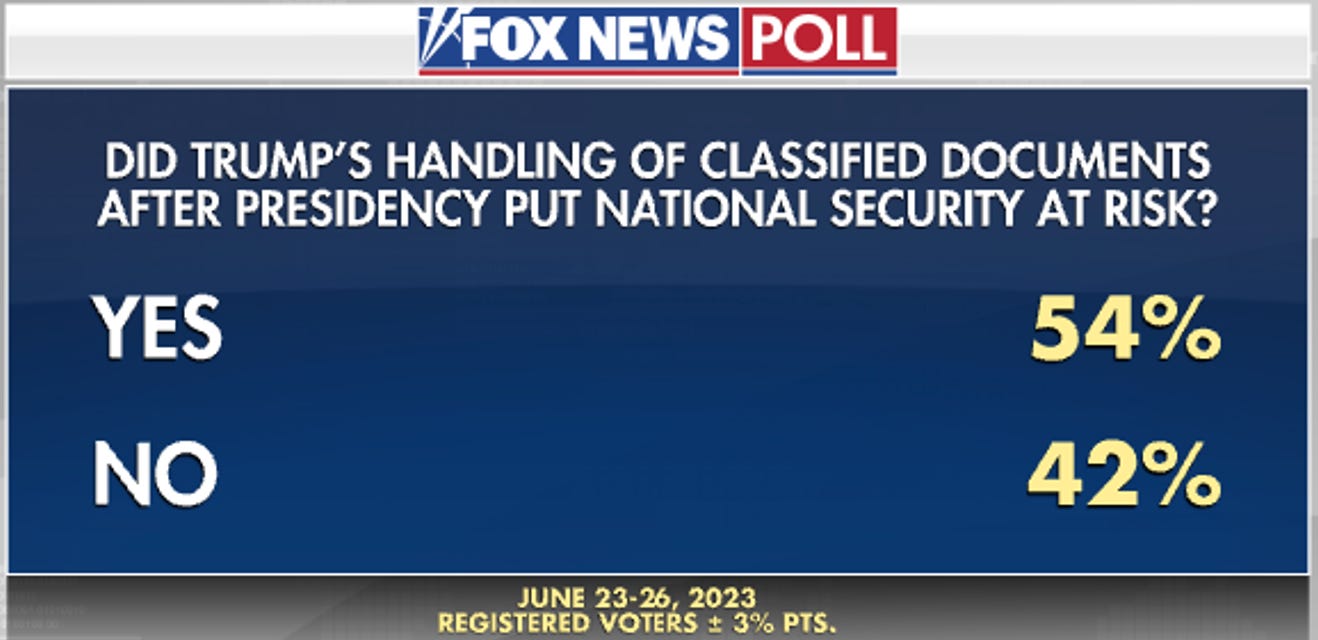TL(PM) DIGEST: Supremes end race-based affirmative action for college admissions
Plus war-related deaths rise, voters see Trump as a national security risk, and Netanyahu appears to blink on key aspect of his judicial coup

1. Supreme Court rules that race-based affirmative action violates the Fourteenth Amendment
What happened? The U.S. Supreme Court ruled today that consideration of race in admissions programs at Harvard University and the University of North Carolina violates the Equal Protection Clause of the Fourteenth Amendment.
Why does it matter? The Court voted 6-3 to strike down race-based affirmative action arguing:
To achieve the educational benefits of diversity, respondents measure the racial composition of their classes using racial categories that are plainly overbroad (expressing, for example, no concern whether South Asian or East Asian students are adequately represented as “Asian”); arbitrary or undefined (the use of the category “Hispanic”); or underinclusive (no category at all for Middle Eastern students). The unclear connection between the goals that respondents seek and the means they employ preclude courts from meaningfully scrutinizing respondents’ admissions programs.
The universities’ main response to these criticisms is “trust us.” They assert that universities are owed deference when using race to benefit some applicants but not others. While this Court has recognized a “tradition of giving a degree of deference to a university’s academic decisions,” it has made clear that deference must exist “within constitutionally prescribed limits.” Grutter, 539 U. S., at 328. Respondents have failed to present an exceedingly persuasive justification for separating students on the basis of race that is measurable and concrete enough to permit judicial review, as the Equal Protection Clause requires.
Respondents’ race-based admissions systems also fail to comply with the Equal Protection Clause’s twin commands that race may never be used as a “negative” and that it may not operate as a stereotype. The First Circuit found that Harvard’s consideration of race has resulted in fewer admissions of Asian-American students. Respondents’ assertion that race is never a negative factor in their admissions programs cannot withstand scrutiny. College admissions are zero-sum, and a benefit provided to some applicants but not to others necessarily advantages the former at the expense of the latter.
TLP’s take: The Court’s ruling today is entirely consistent with the views of an overwhelming majority of Americans—including a plurality of black Americans—who think that colleges and universities should not be allowed to consider an applicant’s race at all in admissions decisions. Rather than just bemoan the ruling, American institutions and political parties should move to develop constitutionally valid, “class-based equality” measures in higher education to assist those Americans of all backgrounds—in all parts of the country—who lack the opportunities and resources necessary to make it to college and succeed.
2. War deaths on the rise
What happened? Deaths attributable to the world’s wars increased some 96 percent last year to a total of 238,000 according to figures compiled by an Australian think tank and reported by the Washington Post. Russia’s war against Ukraine and the conflict in Ethiopia’s Tigray region account for much of this rise, with a combined 186,000 war-related deaths.
Why does it matter? It’s not surprising that war-related deaths would rise in the year that a major inter-state war broke out for the first time in decades. But it does reverse both long- and short-term trends towards fewer deaths in armed conflicts around the world.
TLP’s take: It’s certainly possible that this higher level of deaths represents the “new normal” of a world with much fiercer geopolitical competition. Recent Ukraine- and Ethiopia-related spikes may not last, but they may well establish a higher, more bloody baseline for war deaths in the years to come.
3. Fox News poll shows majority of voters think Trump put national security at risk
What happened? A new poll from Fox News finds that 54 percent of American voters think Donald Trump put national security at risk with his handling of classified documents after he left office.
Why does it matter? The Fox News poll also finds that 56 percent of voters believe Trump acted illegally, with less than three in 10 saying he was careless but did not act illegally, and only 16 percent saying he did nothing wrong.
TLP’s take: Americans understand that Trump’s hoarding of sensitive security documents that did not belong to him—and then refusing to return them when ordered to in a federal subpoena—highlight how unfit he is for national office. Trump’s legal fate awaits him in a Florida courtroom, but the public’s verdict is clear: Trump acted illegally, put our national security at risk, and should be held accountable for his actions.
4. Netanyahu aims to calm crisis he and his allies created
What happened? Israeli Prime Minister Benjamin Netanyahu gave an interview in the Wall Street Journal where he indicated the new version of his right-wing coalition’s judicial overhaul would not include its most controversial provision, one that would give Israel’s parliament the ability to overturn Supreme Court rulings.
Why does it matter? As the Journal notes, this concession is unlikely to sway Israel’s broad liberal center while at the same time potentially risking Netanyahu’s coalition:
The revisions are unlikely to persuade opposition politicians to support the plan, and risk alienating the religious far-right and ultraorthodox parties that play a critical role in Netanyahu’s coalition government and see the country’s courts as too activist and hostile to their agenda.
TLP’s take: Netanyahu should expect mass protests to continue until he and his far-right coalition give up on their illiberal aspirations—but he can’t expect his coalition to hold together if he does. Israelis and American policymakers should buckle up for a rough summer.
Just one more thing…
Scientists have discovered a low-pitched “hum” of gravitational waves resonating across the universe, a “choir” of supermassive blackholes each contributing unique notes to the broader background tapestry of gravitational waves.








